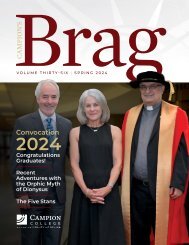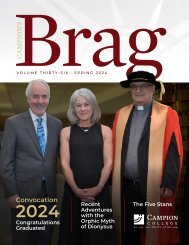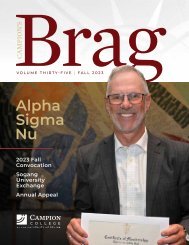Brag Fall 2021
Create successful ePaper yourself
Turn your PDF publications into a flip-book with our unique Google optimized e-Paper software.
By Samantha Lawler<br />
Assistant Professor, Astronomy<br />
MEGACONSTELLATIONS<br />
BLOCKING OUT THE STARS<br />
Dr. Samantha Lawler has become a champion for<br />
stargazers by speaking out about megaconstellations.<br />
For as long as we’ve been human, the<br />
stars have been a constant source of<br />
wonder and knowledge. Countless<br />
human civilizations have traditional<br />
knowledge that is intimately tied to<br />
stargazing: telling us when to plant crops,<br />
when to hunt certain foods, when to expect<br />
seasonal changes.<br />
The night sky is changing. For the past<br />
century, we stargazers have had to contend<br />
with increasing urban light pollution, forcing<br />
us to travel farther and farther from cities and<br />
towns to see the stars as we’ve seen them for<br />
thousands of years. But now a new source<br />
of light pollution threatens the night sky<br />
worldwide.<br />
Several private companies are currently<br />
launching satellites at a frenetic pace:<br />
we have entered the era of satellite<br />
megaconstellations. There are now<br />
approximately 4,000 operational satellites in<br />
orbit. Almost half of them were launched by<br />
American company SpaceX for their Starlink<br />
megaconstellation in the past 2 years, and<br />
they have provisional permission from the<br />
US government to launch 40,000 additional<br />
satellites, a stunningly huge number.<br />
These satellite megaconstellations are<br />
primarily to provide global internet, a<br />
welcome service for many in rural and<br />
remote locations who have long been left<br />
behind by infrastructure developments. But<br />
the cost to the world will be much higher than<br />
most people are aware of, whether or not<br />
they are able to access the services provided.<br />
These satellites are a problem for stargazing<br />
and research astronomy because they reflect<br />
sunlight. I became aware of this problem<br />
when I moved to my farm near Edenwold,<br />
Saskatchewan in 2019, and suddenly had<br />
access to the Milky Way out my back door<br />
for the first time in my life. I noticed the<br />
increase in satellites, and wondered how<br />
bad it would get. I’ve just written a research<br />
paper, currently in press for The Astronomical<br />
Journal, to answer that question.<br />
In this work, I led an all-Canadian team<br />
comprised of myself, Dr. Aaron Boley at<br />
UBC and Dr. Hanno Rein at the University of<br />
Toronto. We built a computer model (see<br />
insert) to predict satellite brightnesses at<br />
different places on Earth at different times<br />
of night in different times of year. Our model<br />
uses 65,000 satellites on the orbits filed by four<br />
30

















